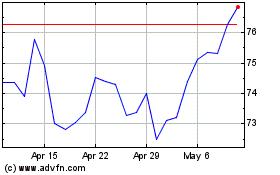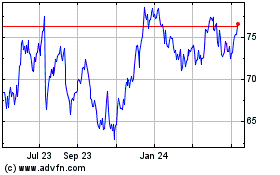State Street's Bankruptcy Plans Fail Federal Scrutiny -- Update
April 13 2016 - 11:55AM
Dow Jones News
By Rachel Louise Ensign
Regulators told State Street Corp. that it needs to make
significant revisions to its plan detailing how it would go through
a potential bankruptcy.
The Federal Reserve and the Federal Deposit Insurance Corp. said
Wednesday that the bank's so-called living will doesn't meet the
requirements of the 2010 Dodd-Frank law, a rebuke that could
eventually impose higher capital requirements or other regulatory
sanctions on the bank.
Regulators said State Street's contingency plan had improved
from its prior plans, but still detailed a number of reasons the
plan was "not credible or would not facilitate an orderly
resolution under the U.S. Bankruptcy Code."
The regulators' review is the latest chapter in a continuing
discussion since the 2008 financial crisis about whether the
largest banks add to overall financial instability or help contain
it in times of economic stress.
"We are committed to addressing the areas outlined by the
Federal Reserve and FDIC," a State Street spokeswoman said. "Given
our strong financial position and capital ratios, we remain
confident in the strength and resiliency of our business."
State Street specializes in custodial services and investment
management, which are businesses that involve trillions of dollars.
It is considered to be among one of the largest, more complex
institutions overseen by the Fed, subjecting it to some of the same
stringent regulatory rules as banks like J.P. Morgan Chase &
Co. and Bank of America Corp.
State Street's plan, which it submitted last summer, detailed
what it would do in a worst-case scenario to collapse without
needing taxpayer assistance. The Boston bank said that in an
emergency, it would try to keep operations at certain lines of its
business from being interrupted by deploying a so-called "single
point of entry" bankruptcy strategy. Under the scenario, a bank's
parent company would enter bankruptcy and the firm's units would be
recapitalized.
But the regulators found deficiencies in the lender's plans
involving shared services and simplifying its legal-entity
structure. They also had issues with the methodology used in some
parts of the submission.
The regulators said the firm has until October to present plans
regulators find acceptable or the agencies could impose higher
capital requirements, restrictions on growth or activities, or
other sanctions.
Despite the negative assessment, State Street shares rose more
than 2% in morning trading after J.P. Morgan released earnings that
beat expectations.
Write to Rachel Louise Ensign at rachel.ensign@wsj.com
(END) Dow Jones Newswires
April 13, 2016 11:40 ET (15:40 GMT)
Copyright (c) 2016 Dow Jones & Company, Inc.
State Street (NYSE:STT)
Historical Stock Chart
From Jun 2024 to Jul 2024

State Street (NYSE:STT)
Historical Stock Chart
From Jul 2023 to Jul 2024
